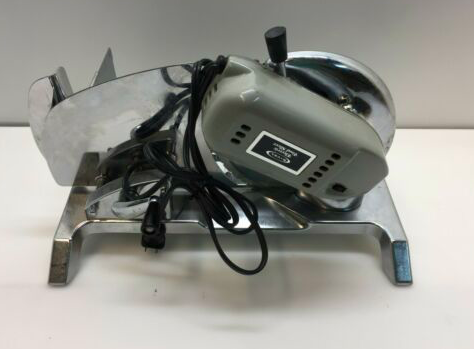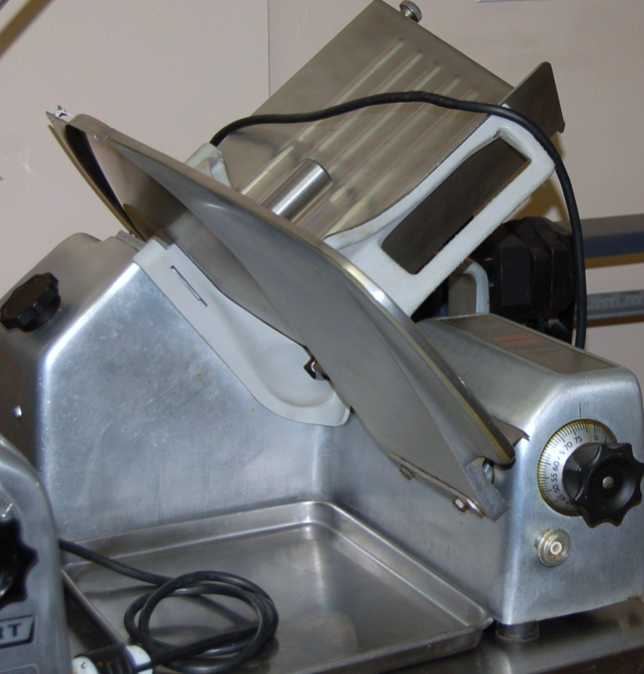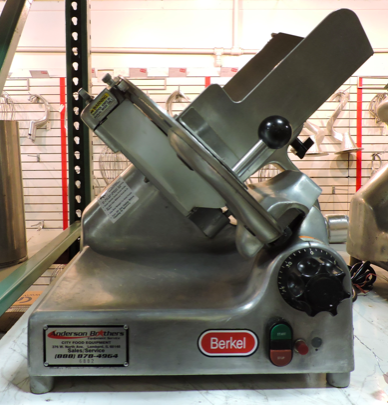Looking for a commercial grade meat slicer that won’t wear out right away? We feature gently used meat slicers for sale by owner. Each listing contains important details like photos, price, location and condition of the slicer. Search our inventory of meat slicers below from top brands like Hobart, Berkel and Weston.
[display_listings l_type=”97″]
Introduction

Whether you’re maximizing your inventory purchasing power by buying whole deli hams and slicing them yourself, working through five pound blocks of swiss cheese, shaving paper-thin ribbons off a frozen ribeye steak, or slicing vegetables into paper thin, translucent rounds, a used commercial meat slicer makes a smart investment that will pay for itself in just a few months.
But choosing the model that’s right for you can be tricky; with dozens and dozens of different makes and models of commercial slicer available, deciding which one has the features you need at the price you can afford can prove challenging.
Budget constraints may make an “entry-level” meat slicer seem like a cost effective way to get into the slicing game, without blowing your equipment budget all at once.
However, most of these inexpensive slicers will quickly burn out with regular use, or when an overzealous prep cook tries to push the machine beyond its technical limitations, as with particularly large chunks of frozen meat, or with repeated use for cheese, which tends to work a machine pretty hard. By buying an inexpensive, entry-level slicer, you may feel like you are saving money now, but the repair bills (not to mention frustration) that’s to come probably aren’t worth it for most businesses.
Heavier-duty slicers typically also include more usability and safety features, designed to keep you and your staff safe and injury-free. This increased productivity (and fewer worker’s compensation claims) you face with a higher-end slicer generally makes up for the difference in cost fairly quickly.
Here are some additional things to keep in mind, when choosing the used commercial meat slicer that’s right for you and your business:
Entry-level slicers are suitable strictly for environments where they will only see an hour or two of light use per day. Many of these slicers lack the ability to slice cheese, and don’t include much in the way of safety or productivity features.
Mid-level slicers tend to have larger blades, allowing you to cut larger pieces of meat or blocks of cheese, and motors with more horsepower that can stand up to more moderate use. While intended to be used mostly with deli meats or vegetables, commercial slicers in this category typically offer a few additional safety features and are designed for a few hours of use per day.
Heavy-duty or premium slicers are the best model a particular manufacturer has to offer. These are designed for constant use (such as in a supermarket, deli, specialty butcher, or convenience store) and boast designs that feature improved safety, and better control over slice precision, speed, and productivity.
What Are Some Design Features to Consider in a Used Commercial Meat Slicer?

In addition to these broad categories of used commercial meat slicer technology, most models have a few other pieces of vocabulary that you’ll want to become familiar with. These include:
Horsepower. As a general rule of thumb, more horsepower=more slicing power. Higher horsepower slicers are designed for more frequent use, and have the power to handle both large pieces of meat and difficult-to-slice foods like cheese.
Blade size. Mid-level and premium slicers typically have larger cutting blades than their economy counterparts. Mid-level and heavy duty slicers have blades which measure 12-14″ across, versus 9″ and 10″ for less expensive slicers.
Product tray (or carriage) size. Most used commercial meat slicers can accommodate a product size of between 7 and 12″ in diameter, within the tray or carriage. For use with larger cuts of meat or cheese, check with the manufacturer to make sure that your slicer can handle these larger products.
Manual vs. automatic slicing. For high-use environments, such as in a deli or grocery store, an automatic slicer can be a both a time and forearm muscle saver. Automatic slicers include an electric motor, which moves the carriage back and forth against the blade at up to 60 slices per minute, allowing “set and forget” functionality without the need for a staff member. Remember, too, that almost all automatic slicers also have a manual setting, so the primary consideration here is how much slicing your business will need to do each day.
Belt driven or gear-driven motors. Belt driven commercial meat slicers are by far the most common, although we are starting to see more gear-driven models. Hypothetically, a gear-driven slicer should be more durable, but when your meat slicer does eventually require repair (as all meat slicers do), repairing a gear-driven model will be significantly more time consuming and costly.
Cleaning leg or kickstand. Some higher-end slicers offer a kickstand-style leg. This convenient usability features makes it easier for staff to balance the meat slicer in the air for more thorough cleaning around and underneath the unit.
What Can I Do With a Used Commercial Meat Slicer?

The most common use for commercial meat slicers is for slicing whole cuts of packaged deli meats or cheeses, but the uses for a gigantic, razor-sharp spinning blade in a commercial kitchen are nearly endless.
A commercial meat slicer is well-suited for making precise, consistent cuts on all kinds of vegetables, including onions, potatoes, eggplant, green peppers, cucumbers, radishes (watch those fingers!) and much, much more.
What are Some Safety and Usability Features to Look For in a Used Commercial Meat Slicer?

Nearly everyone who works in the foodservice industry has a horror story involving a meat slicer. Injuries are common, and can range from minor skinned knuckles to life-altering loss of limb. Fortunately, nearly all of these types of injuries are preventable, and owe more to carelessness or misuse than any dangers inherent in the machine itself.
Proper employee training is of critical importance, and a commercial meat slicer with a few extra safety features will go a long way to ensure that your employees remain productive and safe.
Knife guards. As a rule, most commercial meat slicers make exposure to the actual blade as difficult as possible, using a knife guard. This can be removed on some slicers to make cleaning easier; on others, it is permanently mounted to the body of the slicer itself.
No-volt release. This is an important safety feature that requires the operator to push the power button to turn the slicer on after it has been unplugged, as it would be for cleaning, repair, or other transport. This prevents the slicer from “coming to life” unexpectedly after the power is cut or disrupted.
Gauge plate interlock. Another important safety feature found on some mid-level and heavy duty slicers, this lock requires the gauge plate to be set to zero (thus blocking exposure to the blade) in order for the carriage to be removed for cleaning.
How Do I Evaluate a Used Commercial Meat Slicer?

When evaluating a used commercial meat slicer for potential purchase, there are a few important things to consider. First, select a meat slicer that uses all stainless-steel blades, since these are less prone to rust or corrosion. A good meat slicer should also have a built-in blade sharpener, to make dangerous blade changes less frequent and save the cost of sharpening professionally.
Inspect the unit thoroughly for any misaligned or loose parts, and ensure that the carriage glides freely along its tracks. Be wary of used commercial meat slicers that are missing a blade guard, or slicers which show any signs of tampering; some chefs may disable some safety features as a means of increasing efficiency, which could mean a lawsuit waiting to happen.
Select a meat slicer that comes with its original operating manual, both for maintenance, troubleshooting, and to assist with employee training. Turn on the slicer, and listen for noisy or strained motors. Motors that are approaching burnout will also typically produce a telltale odor, which indicates that a slicer has been overworked or misused. Click here to browse our full used restaurant equipment inventory.
